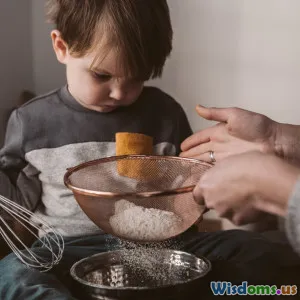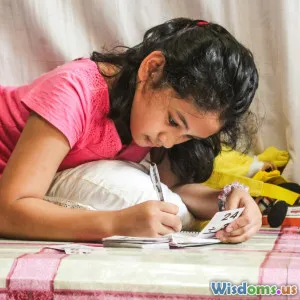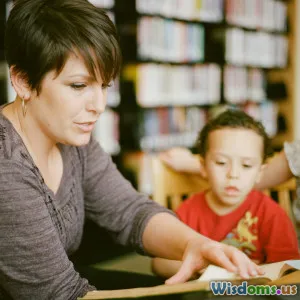
Cooking With Kids Lessons in Patience and Family Bonding
8 min read Explore how cooking with kids fosters patience and deepens family bonds through shared culinary experiences. (0 Reviews)
Cooking With Kids: Lessons in Patience and Family Bonding
Cooking together is often portrayed as a simple domestic chore, but when kids enter the kitchen, it becomes a dynamic learning environment filled with teachable moments. Beyond just preparing food, cooking with children offers a valuable opportunity to cultivate patience and reinforce family bonds in ways that last a lifetime.
Introduction
Imagine the aroma of freshly baked cookies filling your home while your little one eagerly sprinkles chocolate chips into the batter, fingers sticky and eyes wide with excitement. At first glance, this may seem messy or time-consuming; however, this scene encapsulates much more than the joy of eating sweets. It symbolizes moments of teaching patience, savoring togetherness, and creating memories that go far beyond the kitchen.
According to a 2011 study published in the Journal of Nutrition Education and Behavior, children who participate regularly in cooking at home show better dietary habits including increased preference for fruits and vegetables. Beyond nutrition, the cooking process hones crucial skills — especially patience — making it a powerful medium for family growth and learning.
The Power of Patience in the Kitchen
Patience is one of the most profound virtues children can learn, but it's not easily taught through lectures or admonishments. Cooking offers a hands-on way for kids to develop patience organically.
Understanding Processes and Timelines
Consider making homemade bread. The dough requires kneading, rising, and baking — each step demanding waiting and attentive observation. Children learn that rushing the process won’t yield good results and that some things need time to develop, mirroring real-life situations.
Irene, a mother of three, shares: “When my son helps me bake bread, he learns to wait for the dough to rise. At first, he wanted to rush it, but gradually he understood that patience pays off. It’s been beautiful to see him transferring that lesson into his schoolwork and friendships.”
Managing Mistakes Calmly
Kids often face frustration when a recipe doesn’t go perfectly the first time. Cooking encourages them to juggle these emotions as they adapt and retry, fostering resilience and a patient mindset. For instance, if their cupcakes collapse or sauce thickens too much, parents can encourage problem-solving rather than disappointment.
Delayed Gratification
Waiting to taste food after investing effort helps children appreciate delayed rewards — a key aspect of patience linked to greater emotional regulation and success later in life. The celebrated Stanford marshmallow experiment illustrates how the ability to delay gratification is tied to better outcomes; cooking helps nurture this skill within a pleasant and immediate context.
Weaving Family Bonds Through Food Preparation
Cooking with kids is a multidimensional activity that extends well beyond skill-building into the realm of emotional connection and family cohesion.
Shared Responsibilities Build Teamwork
When parents and children collaborate on preparing a meal, everyone contributes to a shared goal. This sense of collective effort strengthens relationships. Children feel valued and responsible, while parents enjoy mentoring roles.
Chef and educator Nathan Myhrvold notes: “Food can be the ultimate connector because it requires cooperation, discussion, and patience. It's a living language within families.”
Creating Traditions and Memories
Family meals prepared together establish traditions anchored in love and shared experience. Whether it’s crafting Grandma’s pie recipe or making pizza from scratch every Friday night, these rituals become cherished memories that reinforce familial identity.
Communication and Learning Opportunities
Cooking encourages multi-generational communication. As children ask questions about ingredients, history, or culinary techniques, parents and grandparents provide stories and cultural context. This exchange enriches understanding and appreciation of heritage.
Practical Tips for Cooking with Kids
To harness cooking as a tool for patience and bonding, consider the following practical advice:
Start with Simple Recipes
Choose easy, kid-friendly recipes requiring minimal steps, such as fruit salad, smoothies, or homemade pizzas. Success breeds confidence and eagerness to engage.
Assign Age-Appropriate Tasks
Young children (3-5 years) can do washing vegetables or stirring batter. Older kids can measure ingredients, use safe knives under supervision, or read recipes aloud.
Embrace Mess and Imperfection
Allow spills and mistakes as part of learning. Focus on the process, not just the outcome, helping kids enjoy without pressure.
Set Clear Expectations and Encourage Patience
Explain how certain results require waiting. Use timers or visual aids to make wait times tangible and fun.
Make It Fun and Celebrate Efforts
Incorporate storytelling about ingredients or culinary history. Praise patience and cooperation, reinforcing the value beyond the food itself.
Safety First
Teach proper hygiene, kitchen safety rules, and supervise cutting or use of appliances consistently.
Real World Impact and Benefits
Families who regularly cook together report higher levels of connection and lower rates of childhood behavioral issues. The Harvard Family Research Project highlights how meaningful family interactions during routine activities — such as meal preparation — improve children's social skills and emotional health.
Moreover, in addition to improving patience and family unity, children who cook with parents often display increased creativity and independence. This multifaceted activity becomes a cornerstone for nurturing well-rounded individuals.
Conclusion
Cooking with kids is an enriching experience that transcends mere meal preparation. It is a powerful medium for teaching patience — a skill that permeates all aspects of life — while simultaneously acting as a catalyst for forging strong, loving family bonds. By savoring the process together, embracing imperfections, and celebrating learning moments, families cultivate resilience, communication, and joy.
Ultimately, the kitchen becomes a classroom, playground, and sanctuary where patience is practiced, family ties are woven tighter, and wonderful memories are cooked up one recipe at a time. Whether it’s your first time or you’ve already welcomed tiny chefs into your kitchen, the act of cooking together holds timeless value worth embracing.
References
- Utter, J. et al. ((2011) “The role of cooking in adolescents’ nutrition.” Journal of Nutrition Education and Behavior.
- Stanford Marshmallow Experiment, Walter Mischel (1972).
- Harvard Family Research Project. "Family Involvement in K-12 Education.
- Nathan Myhrvold, "Modernist Cuisine" (2011).
Rate the Post
User Reviews
Popular Posts





















